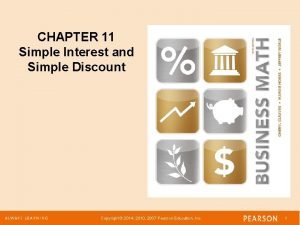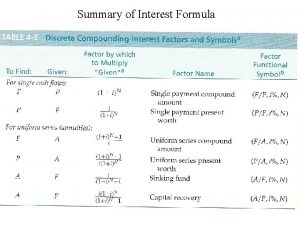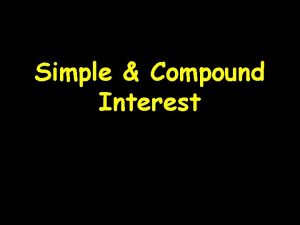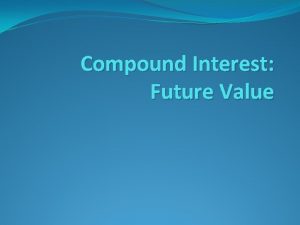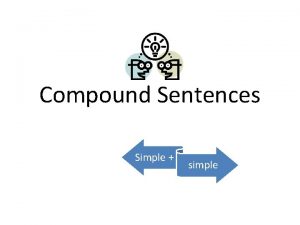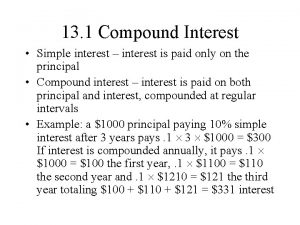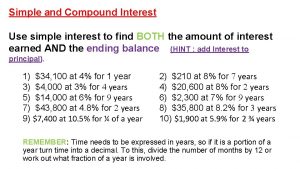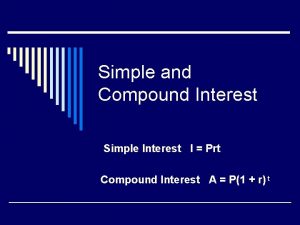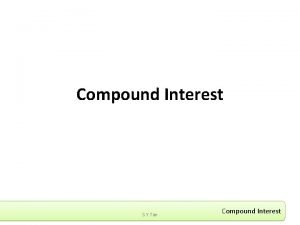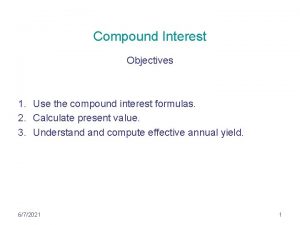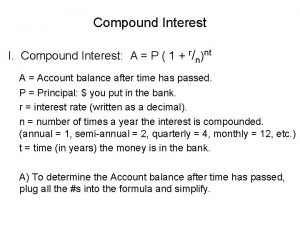Module gtf 1 Simple versus Compound Interest What














- Slides: 14

Module gtf 1 Simple versus Compound Interest What is the difference between simple and compound interest and does it really matter? There are two main methods for computing interest. Do you know the difference between them? Do you know what difference it makes in a savings account after a period of some years? Prepared for SSAC by Gary Franchy – Davenport University Quantitative concepts and skills Arithmetic Growth Geometric Growth Forward Modeling Function, linear Function, exponential Graph, XY (scatter) © The Washington Center for Improving the Quality of Undergraduate Education. All rights reserved. 2005 1

Overview of Module Simple interest is an example of arithmetic growth where the amount of interest generated each term is constant; it is based on only the starting amount. Year to year there is a constant difference in the value of the savings account, and so the successive values track a linear function. Compound interest is an example of geometric growth where the amount of interest generated each term increases because it is based on both the starting amount and the previously earned interest. Year to year there is a constant ratio of the values in the savings account, and so the successive values track an exponential function. Accordingly, compound interest is commonly said to exhibit exponential growth, Slides 3 -4 ask you to set up your worksheet and format the cells. Slides 5 -9 have you computing simple and compound interest for a set period of time and interest rate. You will perform the calculation, graph the increasing savings accounts, and draw trendlines through the plotted functions for the linearly increasing and geometrically increasing values. Slides 10 -12 ask you to calculate the difference between the two types of accounts using a variety of interest rates. Slides 13 -14 give the assignment to hand in. 2

Question 1 What is the difference in results between savings accounts that use simple and compound interest when you invest $100, 000 at 8% for 25 years? Type in the “%” symbol when entering percents; otherwise you must enter the decimal form. One way to answer the question with a spreadsheet is to lay it out year by year. Recreate this spreadsheet = Cell with a number in it = Cell with a formula in it 3

Question 1 Format these cells as currency rounded to the nearest dollar. To format cells: 1. Select the cells. 2. Right-click the mouse. 3. Select “Format Cells”. 4. Choose “Number” tab. 5. Choose “Currency”. 6. Adjust “Decimal Places” to the desired number of places. 7. Select “OK”. 4

Question 1 Compute the results for future value for each year in the column labeled “Simple”. The Simple Interest Formula: Where FV = Future Value ($) PV = Present Value ($) r = Interest Rate t = Time (Years) 5

Question 1 Compute the results for future value for each year in the column labeled “Compound”. The Compound Interest Formula: Where FV = Future Value ($) PV = Present Value ($) r = Interest Rate t = Time (Years) 6

Question 1 Now create a single scatter graph where future value is on the y-axis and time is on the x-axis. Plot the values for both accounts on the same graph. To draw a graph, you may either click on the chart wizard button or use “Insert Chart” from the menu. 7

Question 1 Add trendlines to each graph. To add a trendline: 1. Place mouse over any data point of the desired function. 2. Right-click the mouse. 3. Select “Add Trendline”. 4. Choose the function that resembles the pattern 8

Question 1 The difference between them is almost $400, 000. The difference between them is exactly $384, 848. 9

Question 2 What is the difference in results between savings accounts that use simple and compound interest when you invest $100, 000 at 12% for 25 years? Note the change of scale on the y-axis 10

Question 3 What is the difference in results between savings accounts that use simple and compound interest when you invest $100, 000 at 3% for 25 years? Note the change of scale on the y-axis 11

Question 4 What is the difference in results between savings accounts that use simple and compound interest when you invest $100, 000 at 20% for 25 years? Note the change of scale on the y-axis 12

Assignment 1. Expand the number of years on your spreadsheet to 50 and redo the graph to include the new values. Does the compound interest graph for an interest rate of 3% still look linear? (Refer to Slide 11 for comparison. ) 2. How long does it take for $10, 000 to double at 5% using simple interest? 3. How long does it take for $10, 000 to double at 5% using compound interest? (round answer to nearest year) 4. Redo questions #2 and #3 using interest rates of 10%, 15%, and 20%? 5. Redo questions #2 through #4 using $2585. Did it make a difference in the amount of time for each to double, and if so, longer or shorter? 13

Assignment 6. Compute the future value using simple interest if you deposit $5, 000 for 20 years at 12%. 7. Compute the future value using compound interest if you deposit $5, 000 for 20 years at 6. 5%. 8. How do the results from questions #6 and #7 compare? 9. Savings Accounts, Certificates of Deposit (CDs), New Car Loans, Credit Cards, and Mortgages – which of these use simple and which use compound interest? 10. Based on your answer to question #9, which interest method is used most and why do you think that is the case? 14
 Simple interest
Simple interest Simple and compound interest module
Simple and compound interest module Rpp gtf pns
Rpp gtf pns Grid torrent
Grid torrent Finance grade 11 maths lit
Finance grade 11 maths lit Characteristics of lyric
Characteristics of lyric Simple and compound interest practice worksheet answer key
Simple and compound interest practice worksheet answer key How to find principal amount
How to find principal amount Nominal interest rate
Nominal interest rate Bruno dislikes sitting on the beach
Bruno dislikes sitting on the beach Quiz on simple compound and complex sentences
Quiz on simple compound and complex sentences Simple interest and simple discount
Simple interest and simple discount Simple discount notes
Simple discount notes What is real interest rate and nominal interest rate
What is real interest rate and nominal interest rate Discrete compounding formula
Discrete compounding formula











